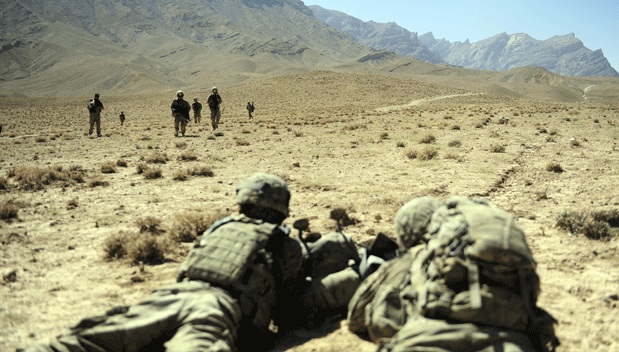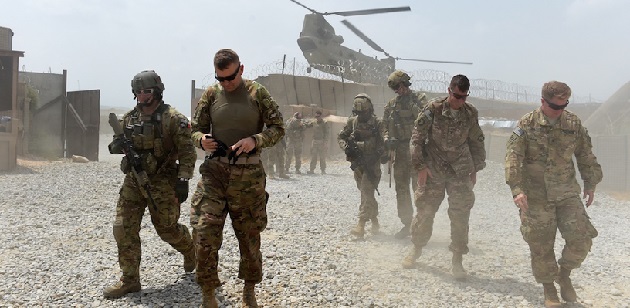By Kate Brannen
Why Obama dropping his promise to end America’s longest war is going to give contractors billions of dollars. In August, the nation’s top military officer came to President Barack Obama and bluntly asked him to break a promise to bring the last American troops home from Afghanistan by the time the president left office.
Obama had been repeating the vow for years, but Gen. Martin Dempsey, then-chairman of the Joint Chiefs of Staff, said the United States needed to keep at least 5,000 troops in Afghanistan beyond 2016 to ensure that the Islamic State didn’t take root there and to prevent al Qaeda from moving back into the country. In July, the Pentagon discovered that the terrorist group responsible for the 9/11 attacks had been running a pair of large training camps in southern Afghanistan, including one that covered nearly 30 square miles.
The president, anxious to prevent Afghanistan from turning into another Iraq, told Dempsey that he was willing to consider the troop request. First, though, he wanted the general to tell him the “no kidding” cost of keeping U.S. forces there including what the Pentagon would pay the thousands of contractors needed to house, feed, and support U.S. military personnel. Wisened after years of overseeing two wars, Obama didn’t want to let the additional cost of contractors escape him, particularly since the military rarely includes it in its proposals. The exchange was first reported by the Washington Post. The White House declined to comment on the president’s decision-making.
That Obama even factored “in contracting costs marks an evolution in the way leaders think,” said Sean McFate, a professor at the National Defense University and the author of The Modern Mercenary: Private Armies and What They Mean for World Order. “Just 10 to 15 years ago, contracting costs came as an afterthought,” he said. “Now they are part of strategic planning. This makes sense, since the majority of ground personnel are contracted.”
This is certainly true in Afghanistan, where there are 30,000 contractors working for the Defense Department, according to the latest Pentagon tally. Of these, roughly 10,000 are U.S. citizens. The rest are local or third-country nationals from states like Nepal. The Pentagon figures don’t include the thousands of other contractors working for the State Department, USAID, and the Central Intelligence Agency.
That means Obama’s decision to extend America’s longest war won’t just keep thousands of troops in Afghanistan longer than had been expected; it will also keep thousands of contractors there, ensuring that the gold rush sparked by the 2001 invasion continues for the next several years. That’s good news for companies like Fluor Corp. and DynCorp International, which have been providing U.S. troops with things like electricity and laundry services on their Afghan bases for years. They and the other contractors working for the military stand to earn billions of dollars per year.
It also means the U.S. government is going to have to continue to provide close scrutiny of their work, as major contractors have been accused of overbilling the government, failing to deliver what they promised, abusing their labor force, and, in some cases, committing outright fraud. But contractor wrongdoing will be even harder to detect in the years ahead because the ongoing military draw down will make it extremely difficult for government auditors to travel the country and check on specific projects. U.S. civilian personnel conducting contractor oversight only have access to about 10 percent of the country today, according to an official in the Office of the Special Inspector General for Afghanistan Reconstruction, or SIGAR.
“With the draw down of coalition forces in Afghanistan, the ability of U.S. government personnel to go out and kick the tires in order to provide proper oversight is limited,” said John Sopko, the current head of SIGAR, in a statement to Foreign Policy. “With less of the country accessible, it means the American taxpayer is footing the bill for billions of dollars in projects that a U.S. government employee may never see.”
While Obama may have gotten a clearer picture of the costs of an extended mission in Afghanistan, the American public did not. There was no mention of how much money it would cost to delay the draw down when Obama finally announced in early October that he had decided to keep 9,800 U.S. troops in Afghanistan through most of next year before reducing that footprint to 5,500 for 2017 and beyond. (Under Obama’s original 2014 proposal, only 1,000 troops, all based in Kabul, were scheduled to stay in the country beyond 2016.)

But Todd Harrison, a defense budget expert at the Center for Strategic and International Studies, has come up with a good back-of-the-envelope way of estimating the cost of operations in Afghanistan based on funding trends from 2005 to 2013. When analyzing the data over that time period, Harrison discovered a linear relationship where the total annual cost of operations in Afghanistan equals the number of troops deployed multiplied by $1.3 million the cost per year of keeping each soldier or Marine in the field plus $6 billion in fixed costs that don’t vary with the size of the force. This means the additional cost of keeping 5,500 troops in Afghanistan in fiscal year 2017 is about $13 billion. That would come on top of the money Washington would be spending on American reconstruction projects and to pay for the Afghan security forces.
“So all in all, it would probably end up being about $20 billion,” Harrison said. A large portion of that would go to contractors who are involved in everything from maintaining weapons for Afghan forces to building new infrastructure projects across the country. That doesn’t mean that’s the number you’ll see the Obama administration requesting for its war budget though, Harrison noted. In recent years, the White House has used its war spending bill also known as the Overseas Contingency Operations, or OCO, fund to finance the purchases of $20 billion to $25 billion worth of weapons and other programs that really belong in its base budget. That has allowed it to effectively hide the true cost of some of its procurement efforts. But, Harrison noted, it means the “OCO budget is no longer a good indication of actual war costs.”
As for contractors, the number in Afghanistan has been steadily falling from its peak of 117,000 in 2012, as the number of U.S. troops on the ground shrinks. There were 15,000 more contractors working for the Defense Department in the country last October than there are today. But with Obama’s announcement, that steady reduction will come to a halt, especially among the major contractors who directly support U.S. troops by providing them meals, doing their laundry, and keeping the lights on at the bases in Kandahar, Jalalabad, and Bagram. In Afghanistan, the big players are DynCorp International, based in McLean, Virginia, and Fluor Corp., based in Irving, Texas.
The hundreds of millions of dollars these contractors stand to gain because of the delayed withdrawal in Afghanistan mirrors the lucrative deals the Pentagon has signed with the companies charged with supporting the expanding American troop presence in Iraq. There, contractors like SOS International are winning bids to provide everything from meals to perimeter security at Iraq’s Besmaya Compound and Camp Taji.
The contractors stand to pocket even more in Afghanistan because more U.S. troops are deployed there and the reconstruction effort is ongoing. In early October, DynCorp won a $154 million one-year contract modification to continue providing support to American troops in Afghanistan. According to the company, the contract covers everything from providing the bases with electrical power to sewage and waste management and even food and laundry services.
DynCorp’s original contract for base support in Afghanistan had been awarded in 2009 and has earned the company more than $6 billion. The State Department has also relied heavily on the company to perform work in war zones, especially in Afghanistan. Of the $4 billion the State Department spent on reconstruction projects in Afghanistan between 2002 and 2013, DynCorp won 69 percent, or $2.8 billion, according to an April 2014 SIGAR report.
But DynCorp is not without controversy. It has been charged with over billing the government millions of dollars. SIGAR is also investigating the company, along with Fluor, in connection to reports of human trafficking in Afghanistan. The inspector general has collected evidence that shows that third-country nationals from India, Nepal, and elsewhere have been enticed by labor recruiters to pay improper “recruitment fees” and “kickback payments” to obtain their jobs working for these companies on U.S. bases in Afghanistan. In a statement to FP, DynCorp said it has put policies and procedures in place to educate employees about and prevent human trafficking.
“The company has developed a strict code of ethics and business conduct, which includes a zero tolerance policy on human trafficking; created a position of chief compliance officer; introduced global training programs; and has taken a number of additional steps to ensure a compliant, ethical, [and] successful workplace,” a spokeswoman for the company said.
Fluor said it also strictly adheres to a policy of zero tolerance for human trafficking. “We take any alleged violation of that policy very seriously,” a Fluor spokeswoman told FP. Fluor said it promptly responded to a request for information from SIGAR in July 2014 and has not heard from the inspector general’s office since.
The company will “proudly continue” to support U.S. and coalition forces “in Afghanistan and elsewhere around the world as directed and for as long as there are requirements,” the spokeswoman told FP. KBR, formerly a subsidiary of Halliburton, used to play a much bigger role in Afghanistan, but after years of winning contracts without having to compete for them and facing charges of fraud and overbilling not to mention failing to protect soldiers from harmful chemicals in Iraq the Pentagon decided to change things up and let other companies compete for the business.
While KBR is not providing base support to American soldiers in Afghanistan, it still is working on American military contracts in Iraq, the United Arab Emirates, Kuwait, and other countries. The Supreme Group, headquartered in Dubai, has also seen its business in Afghanistan dry up. It used to feed up to 130,000 troops a day in Afghanistan, raking in a total of $6.8 billion, but lost its multibillion-dollar contract in 2012 to one of its competitors, Dubai-based Anham FZCO.
Then, in December 2014, executives from the Supreme Group pleaded guilty to major fraud against the United States, admitting it had overcharged the government hundreds of millions of dollars for food and water. It agreed to pay $389 million in fines and damages. In a more staggering case of Washington’s quid pro quo economy, retired Army Lt. Gen. Robert Dail was hired in 2008 as president of Supreme Group’s U.S. branch, after giving the company the New Contractor of the Year award in 2007 when he was serving as head of the Defense Logistics Agency, which oversaw the company’s contract in Afghanistan.
The Supreme Group has continued to provide fuel to U.S. and NATO forces, even after it lost its giant food contract. British military police are now investigating claims that the company may have overcharged as much as $700 million in fuel contracts, the Guardian reported last month.
Meanwhile, Anham’s contract is valued at $8 billion. In 2013, the company admitted to the U.S. Commerce and Treasury Departments that it had shipped some of its supplies through Iran because the main route through Pakistan had been closed. These are just some examples of why close scrutiny of overseas contractors is needed, but SIGAR warns that oversight in Afghanistan is becoming increasingly restricted because of security reasons. American civilians are only allowed access to areas in Afghanistan within a one-hour round trip of an advanced medical facility. Because of this, U.S. government officials from the Pentagon, the State Department, and USAID cannot visit reconstruction projects that altogether total more than $725 million of U.S. taxpayer dollars.
Courtesy Foreign Policy.







